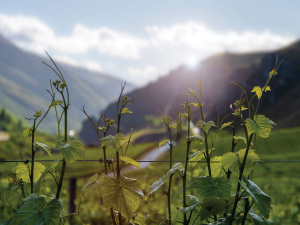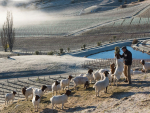Labelled by the European Union as one of the most dangerous plant pathogens in the world, xylella fastidiosa has been slowly spreading around the world since the 1880’s, when it was first noticed causing serious disease in Californian grape crops (Pierce’s disease).
An incursion of xylella, and an associated biosecurity response in New Zealand, would have significant consequences for many of our horticultural industries, and likely for many native plant species as well.
Xylella fastidiosa - what is it?
Xylella is a bacterium which colonises the xylem vessels of plants. As it multiplies, it blocks the xylem tissue, restricting movement of water around the plant. It is capable of killing even mature vines in a period of 1-3 years after infection. The bacterium is transmitted by xylem-feeding insects which vector the spread by taking up the bacteria when feeding from an infected host plant and passing it onto the next plant they feed on. At least one known vector, the meadow spittlebug philaenus spumarius, is widespread in New Zealand.
Xylella is most likely to enter the country on imported plant material, or via the accidental import of an exotic insect vector. New Zealand has strict quarantine measures and testing regimes in place for introductions of new plant material from offshore, and there are particular requirements that must be met for known xylella host species.
Planning for response
New Zealand Winegrowers (NZW) helped to establish and still chairs the Xylella Action Group (XAG), a partnership between NZW, Ministry for Primary Industries (MPI), Summerfruit New Zealand, Citrus New Zealand, and New Zealand Plant Producers Incorporated, that undertakes readiness and response planning for xylella through the Government Industry Agreement. Recently the action group worked through the hypothetical scenario of a xylella incursion based in a small Hawke’s Bay vineyard, designed to test aspects of response plans and decision making, and highlight any gaps where further work needs to be done.
Response measures
Should xylella fastidiosa be detected in New Zealand, the first decision that will need to be made is whether a biosecurity response should occur. Delimitation will be undertaken to determine the likely spread of the pathogen and what kind of response (eradication, containment, slow the spread or straight to long term management) is best suited. In our hypothetical scenario, eradication was deemed feasible as there was no detection of the pathogen outside of the Hawke’s Bay vineyard. Once eradication is decided upon, several response measures would be put into place:
- Restricting the movement of susceptible plant material on and off the affected property. Some types of material could not be moved at all (vines, pruning offcuts) while others (e.g., harvested fruit) would need to be permitted under certain conditions.
- A Notice of Direction directing the destruction of all of the host material on the affected property. In our scenario, this meant all the grapevines on the vineyard (~12,000) would need to be removed and destroyed.
- Setting up a controlled area around the detection site. This is a buffer area around the detection site where movement of susceptible host plants is controlled (not allowed out of the area) to help prevent the spread of the unwanted organism.
- Control of insect vectors within the response zone would also occur.
Compensation
If MPI uses powers under the Biosecurity Act during a response, for example to direct the destruction of property, the owners can claim compensation for those losses. In our scenario, the grower would have been eligible to claim compensation for the vine destruction losses, and production losses, while replacement vines were sourced and grown to maturity, roughly estimated at around $320,000. MPI uses a detailed framework to calculate compensation eligibility and takes into account any loss mitigation factors.
Learnings from the scenario
As a result of working through the scenario, the XAG has identified several short projects that can be undertaken to improve readiness for xylella fastidiosa, including:
- Improving the efficiency of the delimination phase by developing a more rigorous statistical host material sampling plan.
- Determining the requirements for real-time response monitoring dashboards in advance.
- Considering how to respond to a detection of xylella in an insect vector (without a positive host plant detection).
- Development of proactive response communications to industry and the public for the event of a xylella incursion.
- Increasing the understanding of industry around eligibility for compensation and what is required to make a claim, and the understanding of MPI staff of industry processes, costs and seasonal patterns.
- Determining triggers to move from response to a long-term management scenario (or for deciding to go straight to management without an eradication attempt).
These will be incorporated into the future work programme of the action group, with another scenario exercise, this time in the field, also likely to be held next year.
The Basics
- Xylella fastidiosa poses a biosecurity threat to the New Zealand wine industry.
- The bacterial pathogen is spread by spittlebugs and could seriously impact New Zealand's wine, citrus, summerfruit and plant production sectors, as well as some native and amenity species.
- The Xylella Action Group is running a series of scenarios to test readiness and response plans for xylella fastidiosa.
- Anyone suspecting they are seeing symptoms of xylella in their vines should contact the Biosecurity New Zealand pest and disease hotline on 0800 80 99 66.














